4235 Monterey Road
Los Angeles, CA 90032
AREA 3 - URBAN WILDERNESS PRESERVATION AREA
This area is defined by its natural habitats, and by its walking and hiking trails, city
vistas, and opportunities for solitude. It is the area where visitors have a sense of
wilderness, with
opportunity for
adventure and
challenge. It is
mostly steep hillsides
and 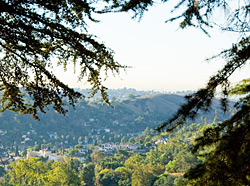 sloping
ridgelines. This
comprises the largest
of the designated
areas; one
which encompasses
substantial biological
resource values.
Presently, access to
the Urban Wilderness
area is via the
main parking lot of Area 2 to the south, or via street parking on Griffin Avenue along the
north and west boundaries of the Park. Numerous other, perhaps unofficial entries are
located throughout the perimeter.
sloping
ridgelines. This
comprises the largest
of the designated
areas; one
which encompasses
substantial biological
resource values.
Presently, access to
the Urban Wilderness
area is via the
main parking lot of Area 2 to the south, or via street parking on Griffin Avenue along the
north and west boundaries of the Park. Numerous other, perhaps unofficial entries are
located throughout the perimeter.
The distinguishing feature of the Urban Wilderness is the presence of extensive stands of southern California black walnut. Depending on aspect to the sun, the walnut trees form an open, walnut woodland of scattered individuals among annual grassland on southfacing slopes, to dense tree cover forming walnut forest on the north-facing slopes, where more moisture is available. As elsewhere in the park, additional shrub and tree species of these woodlands and forest include lemonadeberry, toyon, blue elderberry, and coast live oak. Golden currant is occasionally encountered, and heart-leaf penstemon, and Fuchsiaflowered gooseberry are rare shrubs of the understory.
One occurrence of false indigo, the foodplant of the official butterfly of the state of
California, the California dogface butterfly is known from the park. Other relatively
rare occurrences of plants include fleabane aster, California-Fuchsia, and western
pellitory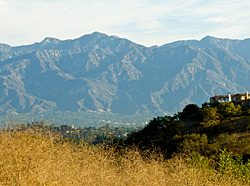 . Because southern California black walnut is a deciduous species, sunlight is
available in the understory of these woodlands and forest during the winter, when soils
are wet, and growth of grasses and forbs is most rapid. Consequently, the understory is
enriched by a number of herbaceous plants, which provide food and cover for wildlife.
The prevalent herbs are aliens, including common chickweed, annual bedstraw,
horehound, short-pod mustard, and several species of ubiquitous annual grasses.
. Because southern California black walnut is a deciduous species, sunlight is
available in the understory of these woodlands and forest during the winter, when soils
are wet, and growth of grasses and forbs is most rapid. Consequently, the understory is
enriched by a number of herbaceous plants, which provide food and cover for wildlife.
The prevalent herbs are aliens, including common chickweed, annual bedstraw,
horehound, short-pod mustard, and several species of ubiquitous annual grasses.
Native plants are also present, especially the pleasantly fragrant California everlasting, and cliff-aster. Blue fiesta flower, and miner's-lettuce are occasionally encountered. Native grasses can also be found including coast melic, California brome, and rarely, giant wildrye or purple needlegrass. Poison-oak, which is also deciduous, wild cucumber, and chaparral honeysuckle are among common vine-like species in the understory.
In addition to walnut woodland and forest, annual grassland dominates substantial
portions of the Urban Wilderness, especially on south-facing slopes. Here, an assemblage
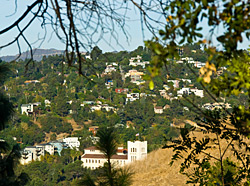 of ubiquitous alien annual grasses frequently prevail, including ripgut brome, red brome,
soft-chess, slender wild oat, foxtail barley, and rat-tail fescue. These areas can also be
locally dominated by forbs, especially black mustard and various alien, thistle-like plants
including tocalote, milk-thistle, bull thistle, common and prickly sow-thistles, Russianthistle,
and bristly ox-tongue. Weedy native herbs such as horseweed and wand-chicory
are relatively common. Although usually associated with coastal sage scrub, the only
known occurrence of the native shrub, California encelia is found on steep south-facing
slopes in the western drainage. Although alien, tree tobacco is common on certain southfacing
slopes, providing for numerous hummingbirds.
of ubiquitous alien annual grasses frequently prevail, including ripgut brome, red brome,
soft-chess, slender wild oat, foxtail barley, and rat-tail fescue. These areas can also be
locally dominated by forbs, especially black mustard and various alien, thistle-like plants
including tocalote, milk-thistle, bull thistle, common and prickly sow-thistles, Russianthistle,
and bristly ox-tongue. Weedy native herbs such as horseweed and wand-chicory
are relatively common. Although usually associated with coastal sage scrub, the only
known occurrence of the native shrub, California encelia is found on steep south-facing
slopes in the western drainage. Although alien, tree tobacco is common on certain southfacing
slopes, providing for numerous hummingbirds.
Among the rarest plant communities in the park, coastal sage scrub is with the one
exception described in Area 1, restricted to northern and western margins of the Urban
Wilderness. In particular, a south-facing slope at the northerly entrance supports a stand
of black sage, California buckwheat, coastal sagebrush, California brickellbush deerweed,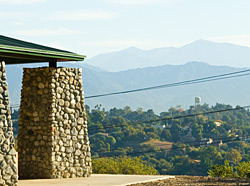 and several species of plants not found elsewhere, including caterpillar and sticky
phacelias, prickly pear, chaparral morning-glory, sawtooth goldenbush, and possibly also
foothill needlegrass.
and several species of plants not found elsewhere, including caterpillar and sticky
phacelias, prickly pear, chaparral morning-glory, sawtooth goldenbush, and possibly also
foothill needlegrass.
To the immediate west of the north entrance is an unusual area of coastal sage scrub with scattered shrubs of coastal sagebrush, coyote brush, blue elderberry, and other uncommon species such as amole. Bordering this latter area on the north is an area with evidently moist subsoils, which supports an impenetrable thicket of California rose. This is the only known (extant) location of the noxious vine, bladder flower at the park. Rather unusual is the occurrence of coastal sage scrub on a steep, north-facing slope to the east of the northern entrance. Here, bush monkeyflower, narrow-leaf bedstraw, and goldenyarrow are dominant, and these species are not known from any other locations in the park. This is also the site of an infestation of red valerian. Other pockets of coastal sagebrush along the western margin are notable as the only locations of species including coastal isocoma, Palmer's goldenbush, and rare occurrences of white everlasting, California-Fuchsia, and long-stemmed buckwheat.
Compared to other areas of the park, the large size, natural condition, and relatively low
levels of human disturbance in the Urban Wilderness provide the best possible of the
existing conditions for wildlife at Debs Park. Furthermore, Arroyo Seco, although
channelized and concrete-lined, provides some degree of connectivity of Debs Park to
natural areas of the upper watershed located in the San Gabriel Mountains. As a result,
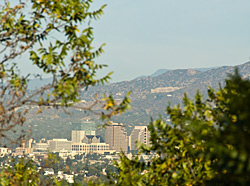 the Urban Wilderness area is expected to support the greatest array of wildlife of any of
the areas. In addition, observations by Mr. Kimball Garrett, ornithologist with the Los
Angeles County Museum of Natural History and Mr. Dan Cooper of National Audubon
reveals that red-shouldered hawk nest in the park here, and possibly even Cooper's hawk
and red-tailed hawk. Also confirmed nesting birds are Band-tailed pigeon, mourning dove,
Anna's hummingbird, western scrub-jay, ash-throated flycatcher, bushtit, BewickÕs wren,
American robin, black-headed grosbeak, and spotted and California towhees. Others
reported likely to breed include black-chinned, Costa's and Allen's hummingbirds, black
phoebe, western screech-owl, great horned owl California thrasher, hooded and BullockÕs
orioles, lesser and Lawrence's goldfinches, and house sparrow.
the Urban Wilderness area is expected to support the greatest array of wildlife of any of
the areas. In addition, observations by Mr. Kimball Garrett, ornithologist with the Los
Angeles County Museum of Natural History and Mr. Dan Cooper of National Audubon
reveals that red-shouldered hawk nest in the park here, and possibly even Cooper's hawk
and red-tailed hawk. Also confirmed nesting birds are Band-tailed pigeon, mourning dove,
Anna's hummingbird, western scrub-jay, ash-throated flycatcher, bushtit, BewickÕs wren,
American robin, black-headed grosbeak, and spotted and California towhees. Others
reported likely to breed include black-chinned, Costa's and Allen's hummingbirds, black
phoebe, western screech-owl, great horned owl California thrasher, hooded and BullockÕs
orioles, lesser and Lawrence's goldfinches, and house sparrow.
Observations of other native wildlife species at the park are rather sparse, among confirmed sightings are coyote (D. Cooper), bottaÕs pocket gopher, broad-handed mole (C. Wishner, Envicom Corporation), desert cottontail, and fox squirrel. The presence of a number of species of bats, and small rodents among shrews, pocket mice, kangaroo rats, harvest mouse, white-footed mice, and woodrats might reasonably be anticipated.
Similarly, observations of amphibians and reptiles are very sparse, and only the western fence lizard is commonly observed. Mr. Dan Cooper, National Audubon, has observed a handful of butterfly species at the park in 1999. These include cabbage white, fiery skipper, skipper (undetermined), western checkered skipper, western tiger swallowtail, marine blue, and gulf fritillary. Ms. Melanie Ingalls, National Audubon observed sara orange-tip in March 1999.
Area 3 Land Use Recommendations:
Within the Urban Wilderness Area, there will be visitor activity or "experience" areas
including Audubon's nature interpretive programs, native habitat restoration, and land
management activities. Here, Audubon will play a leading role in partnership with the
City to provide land stewardship and habitat restoration. Other places of interest
include access points, hiking and walking trails, rest and vista turnouts, and places
with unique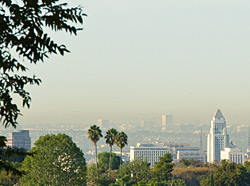 features, such as the future wetland pond. However, throughout this
area, efforts to restore and enhance natural habitats take precedence. The urban
wilderness area requires the most protection in order to preserve and enhance valuable
wildlife habitat. Therefore, recreational uses and facilities will be minimal, with the
enjoyment of nature providing the "recreation."
features, such as the future wetland pond. However, throughout this
area, efforts to restore and enhance natural habitats take precedence. The urban
wilderness area requires the most protection in order to preserve and enhance valuable
wildlife habitat. Therefore, recreational uses and facilities will be minimal, with the
enjoyment of nature providing the "recreation."
Urban Wilderness is the area of the park where visitors step lightly, entering primarily on foot. Visitors will access the area through a series of signed gateways that emphasize and express the distinct quality of the park's woodlands and shrub covered hills. Each gateway into the urban wilderness area will provide an introduction to this resource. Signs will gently remind people to protect the natural resources and to help wildlife by observing and not interfering with their activities.
To implement this vision the following land use design guidelines will apply:
Gazebo
 Currently, the gazebo is in
disrepair and is closed-off to
the public. However, this site
has potential to serve as a
unique visitor experience.
Currently, the gazebo is in
disrepair and is closed-off to
the public. However, this site
has potential to serve as a
unique visitor experience.
Vista Points
Vista points offer exceptional
views to visitors including
panoramic views from the San
Gabriel Mountains to
downtown Los Angeles. To
further enjoy the views from
the Park, implement the
following:
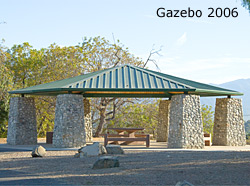 Provide one bench and
trash receptacle at each
identified vista point.
Provide one bench and
trash receptacle at each
identified vista point.
Reservoir Site
To provide a reliable source for irrigation and fire-fighting water, a small reservoir
was constructed in one of the Park's highest hilltop areas. The reservoir lies
wholly within the Urban Wilderness, but it is a developed area including a
prominent hill surrounded by exotic trees and shrubs, and conjoined with a lawn
area and viewpoint. The
margin of the lake is
virtually devoid of
vegetation, as is also the
lake, as park maintenance
staff periodically remove
algae and vegetation. The
soil is compacted, and the
borders of the reservoir are
sprayed regularly to prohibit
vegetation growth. Graffiti
covers the trees and benches
surrounding the reservoir.
Despite its appearance, the reservoir area receives substantial use for picnicking,
fishing 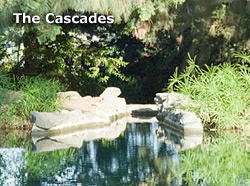 (presumably catfish), and the quite prevalent activity of allowing dogs to
play and retrieve objects from the lake. In addition, below the reservoir to the
north is the "Cascades," an artificial, concrete-rock waterfall that is no longer in
operation. Currently, the reservoir does not support a full complement of wildlife
and vegetation, as its primary purpose is to provide irrigation water.
(presumably catfish), and the quite prevalent activity of allowing dogs to
play and retrieve objects from the lake. In addition, below the reservoir to the
north is the "Cascades," an artificial, concrete-rock waterfall that is no longer in
operation. Currently, the reservoir does not support a full complement of wildlife
and vegetation, as its primary purpose is to provide irrigation water.
Undoubtedly, the local wildlife utilizes the existing reservoir extensively as a source of water. Other potential inhabitants of the lake including fishes and amphibians are unknown. Only one notable plant species is found associated with the lake, a pondweed, tentatively determined to be sago pondweed.
In the future, with the construction of a new water pressure system, this area can be re-created as viable aquatic habitat. The vision for the reservoir is to create an area with wetland plants that support a wide variety of wildlife, from insects to birds (methods for converting the reservoir into a wetland are discussed in the habitat management plan). The new pond would also serve as the focus for wildlife and nature interpretive opportunities. Specific recommendations include:
Interpretive Areas
Audubon will offer a full range of interpretive programs in the Urban Wilderness
area. The Audubon/City native habitat enhancement and restoration projects will
become part of the ongoing interpretive opportunities. Specific interpretive areas,
marked because of their unique ecological attributes include the pond area, coastal
sage scrub, and walnut woodlands. Helping visitors understand the ecological
balance of nature is a high land use priority for the Urban Wilderness area. There
will be numerous opportunities to develop interpretive programs throughout the
area to learn about the site's plants, animals, and sensitive habitats.
Actions to be Discouraged
The maintenance of the park's highly valued wilderness quality will require a
synthesis between soil, water, vegetation, and governing social systems such as the health and safety of its visitors. Long-term viability of the Urban Wilderness area will
depend on the actions of the visitor. Unlawful activities, such as littering, vandalism,
graffiti, hunting, weapons usage, and other harmful activities slowly erode the urban
wilderness experience and destroy wildlife habitat. This area of the park will be
subject to intensive restoration and clean-up activities. A high level of management,
with law enforcement and visitor education efforts is required to make and keep this
area pleasant and safe.
continue to
